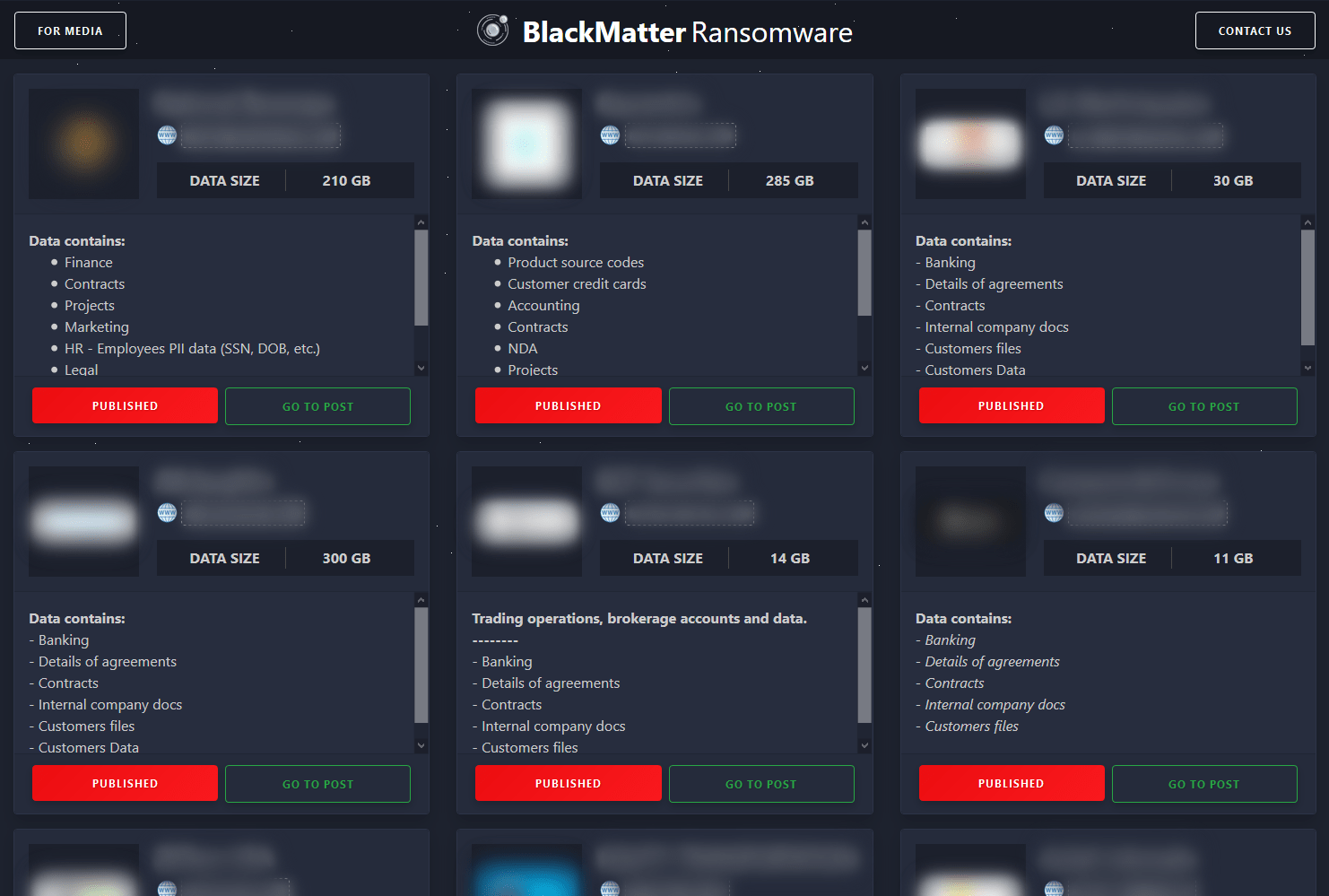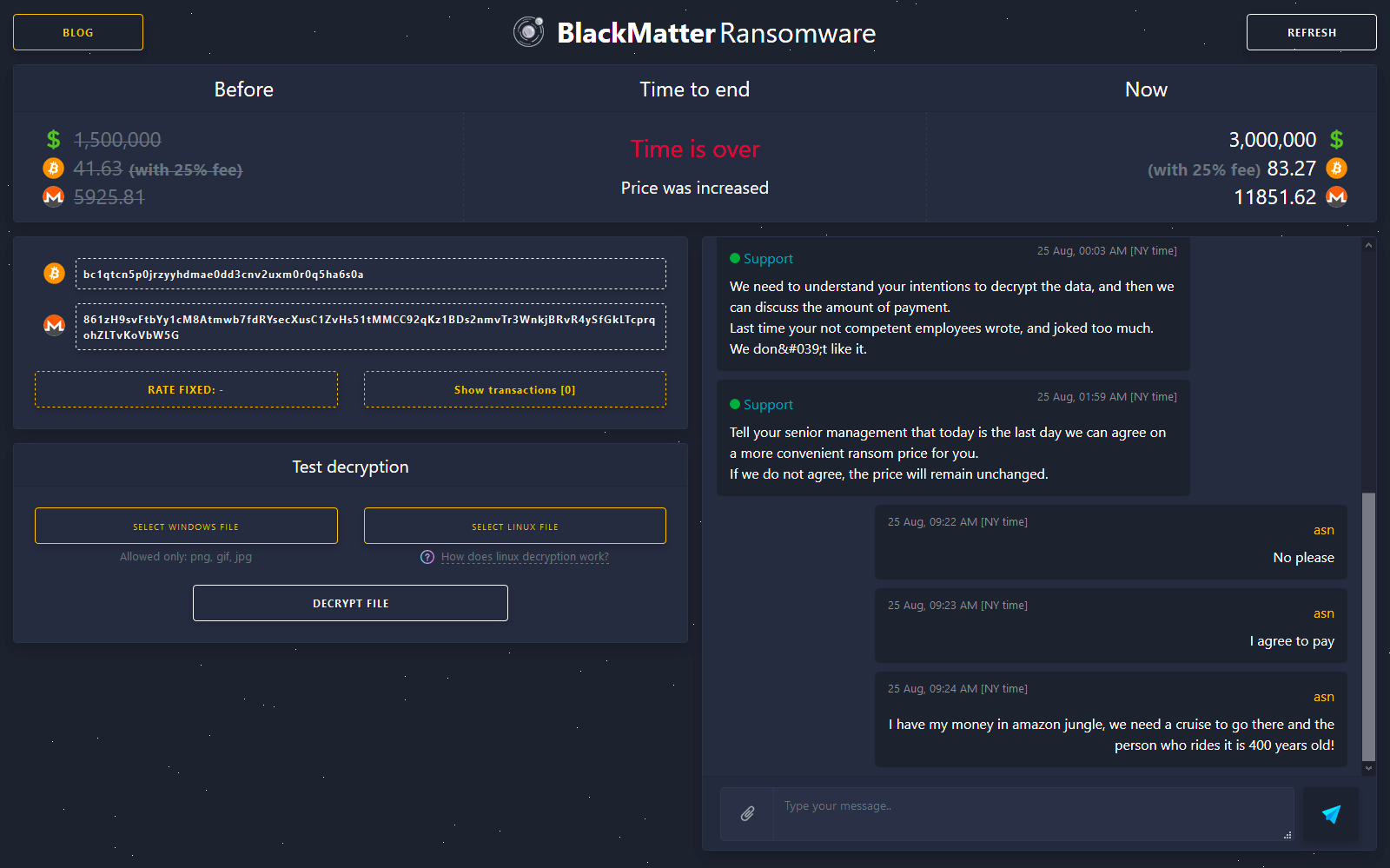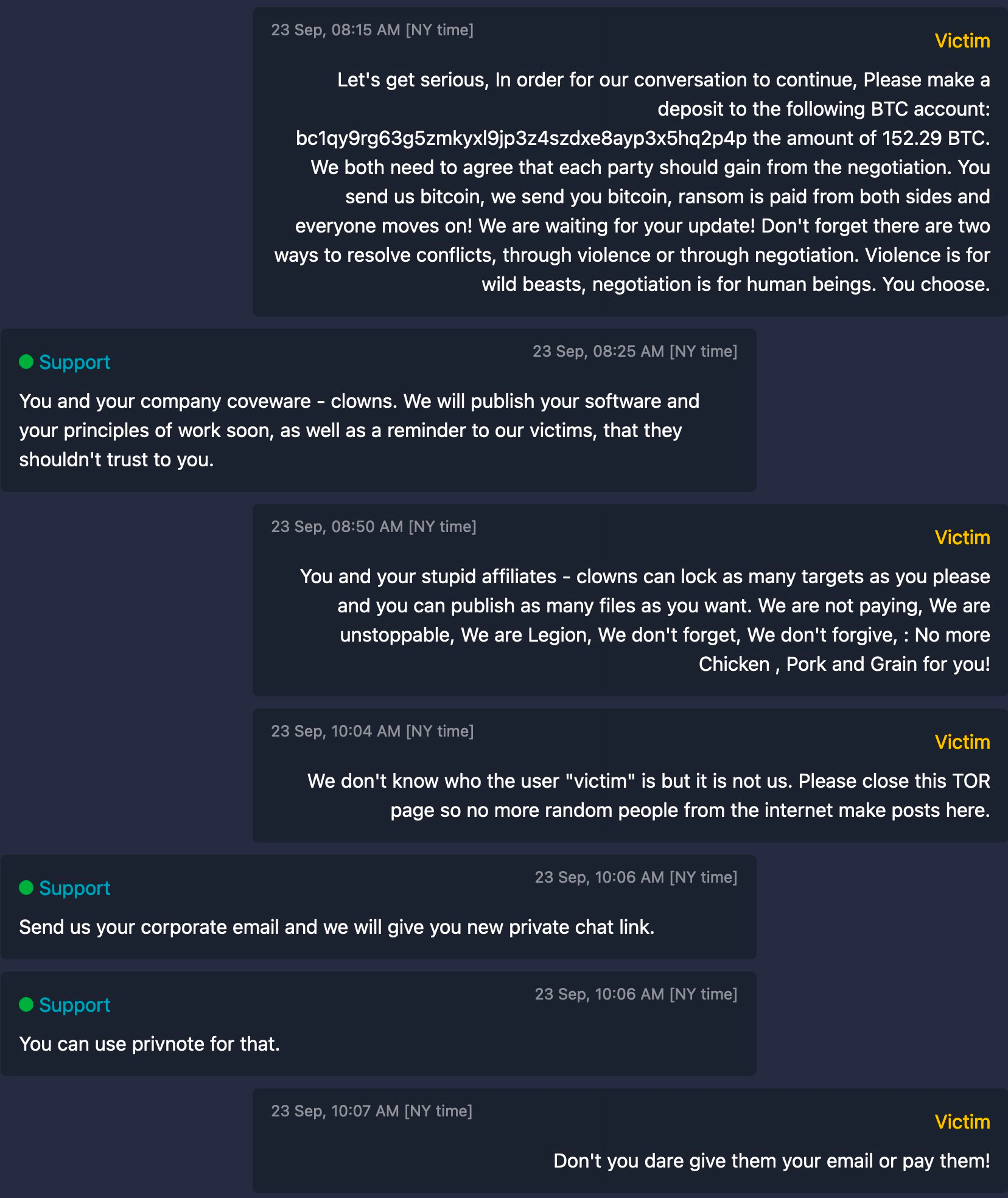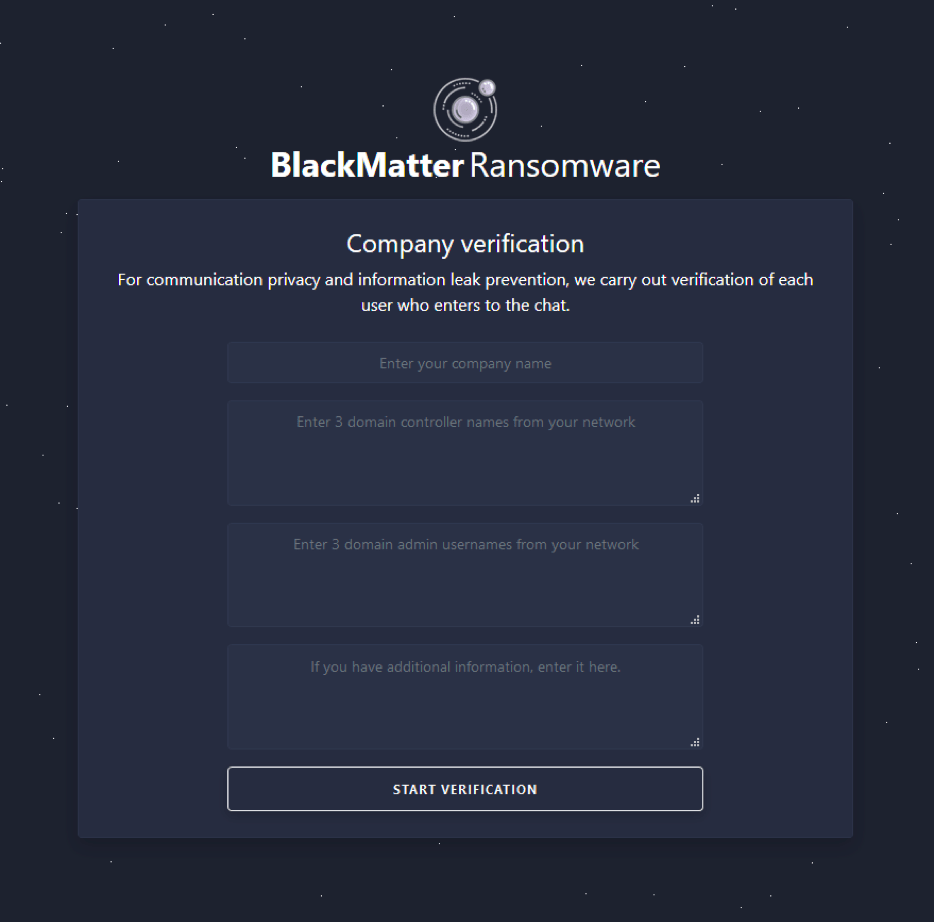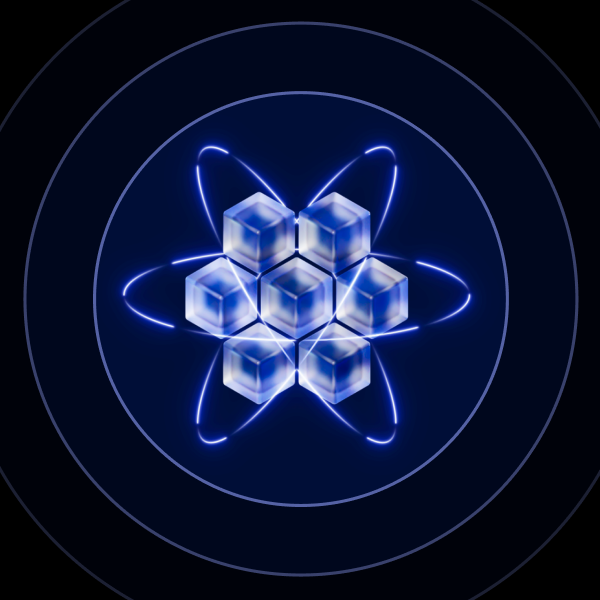Today, on November 3, BlackMatter gang announced it was shutting its Ransomware-as-a-Service program due to the “pressure from the authorities”.
However, it doesn’t mean that BlackMatter’s affiliates will stop malicious activity. They will most likely join other RaaS programs. In addition, this might just be an attempt to have a fresh start under a different name. Just like BlackMatter was a rebranding of DarkSide, a new successor may appear soon. Therefore, given the similarities that we observed between DarkSide and BlackMatter ransomware back in August, it’s important to be aware of the latest ransomware versions’ features: malware configuration, encryption mechanisms in use etc.
For this purpose the experts from Group-IB’s Digital Forensics and Incident Response Team analyzed new BlackMatter samples for Windows and Linux, Andrey Zhdanov, Group-IB’s threat hunter, will share new data on his findings.
A US architectural firm was among the first to fall victim to BlackMatter in late July 2021. Since then, the BlackMatter operators’ appetites have grown considerably, the frequency of attacks has increased, and the threat actors seem to have been constantly improving their tools. The average ransom demand is $5.3 million, with the maximum, which the attackers demanded from Japan’s Olympus Corporation, reaching $30 million.
BlackMatter affiliates try their best to pick their victims carefully, so as not to draw too much attention, but they are not exactly succeeding. Since the first BlackMatter attacks were reported, they have received a lot of very close attention from threat researchers. And on 18 October 2021, the CISA, FBI, and NSA issued joint recommendations, naming BlackMatter ransomware responsible for attacks on U.S. critical infrastructure that had begun in July 2021. As of November 2021, the list of BlackMatter victims consists of more than 50 companies based in the US, Austria, Italy, France, Japan, and other countries.
BlackMatter for Windows
Depending on command line parameters, ransomware for Windows can operate in five different modes. We were able to obtain command line arguments based on analysis of their hashes.
–path [PATH] – encryption of the specified object (directory, file, network resource).
–safe – self-registration in the RunOnce key of system registry, reboot for file encryption in safe mode.
–wall – creating a BMP image with information about encryption of files and setting it as the desktop wallpaper.
[PATH] – encryption of a specified directory/file.
When other parameters are set or any parameters are absent, the system is fully encrypted according to the configuration settings. Upon completing the encryption, the ransomware creates a BMP image alerting that files have been encrypted, which it then sets as the desktop wallpaper. Starting from version 1.4, the ransomware can also print the text of the demand for ransom on the victim’s default printer.
When BlackMatter launches, it checks the rights of the current user and, if necessary, tries to bypass the UAC (User Account Control) through privilege escalation using the ICMLuaUtil COM interface. Also, if the appropriate flag is set in the configuration, it attempts to authenticate using the credentials contained in the configuration data.
Before starting the encryption, BlackMatter deletes shadow copies of partitions using WQL queries (WMI Query Language).
To encrypt files, BlackMatter uses the most efficient multithreading implementation based on the use of the I/O (input/output) completion port. The malware also sets the highest priority (THREAD_PRIORITY_HIGHEST) for the file enumeration and encryption streams. By default, only the first megabyte of file contents is encrypted. In earlier versions, data was encrypted using Salsa20. Apparently, the authors of BlackMatter, just like the authors of another extortionist Petya five years ago, made mistakes in the implementation of the Salsa20 algorithm. Starting from version 1.9, the contents of the files are encrypted already using a modified version of the implementation of the ChaCha20 algorithm, presumably taken from CryptoPP library. Furthermore, the ChaCha20 encryption algorithm is implemented using SSSE3 processor instructions. ChaCha20 keys are encrypted using the RSA-1024 public key. A data block with an encrypted key is appended to the end of the file. The names of the encrypted files are as follows:
FILENAME – is the original name of the file.
VICTIM_ID – is the victim ID generated on the basis of the string contained in the MachineGuid value of the HKLM\SOFTWARE\Microsoft\Cryptography registry key.
The BlackMatter configuration contains the names of directories, files and extensions skipped during the encryption process as lists of checksums (hashes).
In each processed directory, the ransomware creates text files containing the demand for ransom:
Configuration
The BlackMatter configuration data for Windows is contained in a section disguised as a “.rsrc” resource section, but there are no resources in it.
The first 64-bit number (0F8B2AB512017D0F5h) in the section represents the initial value for the pseudo-random sequence generator (random seed) used to encrypt the program data. The next 32-bit value represents the actual size of the configuration data. Prior to encryption, the configuration data was pre-compressed using the aPLib compression algorithm, which is popular among ransomware developers. Previously, this algorithm was found, for example, in such ransomware families as DarkSide, DoppelPaymer, Clop, and others.

Configuration data after decryption and decompression.
| Offset | Description |
|---|---|
| 000h | RSA-1024 public key. |
| 080h | ‘bot-company’ 16-bit Company ID |
| 090h | AES-128 ECB key for encrypting data that is transmitted to the threat actors. |
| 0A0h | Logical one-byte flags that define the ransomware settings. |
| Version below 1.9 | |
| 0A8h | Offset table of configuration parameter values. |
| 0D0h | Configuration parameter values. |
| Version 1.9 and higher | |
| 0A9h | Offset table of configuration parameter values. |
| 0D1h | Checksum of the contents of the text file containing the ransom demand. This checksum is used by ransomware to avoid the encryption of its text files containing the demand for ransom. |
| 0D5h | Configuration parameter values. |
Logical flags that indicate the ransomware settings:
| Flag index | Description |
|---|---|
| 0 | Encryption of one-megabyte blocks in large files at intervals that depend on the file size |
| 1 | Attempt authentication using the credentials contained in the configuration |
| 2 | Mount partitions and encrypt files on them. Starting from version 1.4, if this flag is set, Microsoft Exchange files contained in the “%ExchangeInstallPath%\Mailbox” directory are also encrypted |
| 3 | Encrypt files on available network resources. The program also lists Active Directory computers using LDAP queries. |
| 4 | Terminate processes that contain the specified substrings in their names. The list of substrings is contained in the configuration data. |
| 5 | Stop and delete services. A list of service names is contained in the configuration data. |
| 6 | Create and check the mutex: Global\[MUTEX_NAME] MUTEX_NAME – is the mutex name generated from the string from the MachineGuid registry parameter. |
| 7 | Print the text file with the ransom demand when the encryption is complete (version 1.9 and higher). |
| 8 | Transmit data about the compromised system and encryption results to threat actors. Information in encrypted form (AES-128 ECB) is sent as HTTP POST requests. The list of addresses is contained in the configuration data. |
Offset table of configuration parameter values
The table contains 32-bit numbers that represent offsets relative to the beginning of the list itself to the rest of the configuration data fields as Base64 strings, ending with a null byte. If the offset is 0, there is no field value.
| Offset | Description |
|---|---|
| 00h | Offset the list of checksums of directory names that are skipped during encryption |
| 04h | Offset the list of checksums of files that are skipped during encryption |
| 08h | Offset the list of checksums of file extensions skipped during encryption |
| 0Ch | Offset the list of checksums of computer names that are not encrypted in safe mode (version 1.9 and higher) |
| 10h | Not used |
| 14h | Offset the list of process name substrings |
| 18h | Offset the list of service names |
| 1Ch | Offset the list of internet addresses for transmitting identification data |
| 20h | Offset the encrypted list of credentials |
| 24h | Offset the encrypted contents of the text file that contains the ransom demand |
Known versions
| Version | PE timestamp (UTC) | Description |
|---|---|---|
| 1.2 | 2021-07-23 20:51:18 | The first detected version of BlackMatter that was used for an attack. |
| 2021-07-23 20:51:30 | DLL implementation of the ransomware. Some of the detected samples were contained in obfuscated PowerShell scripts and were injected into the current PowerShell process when the scripts were run. | |
| 1.4 | 2021-07-29 18:00:47 | 1) Added the ability to encrypt Microsoft Exchange files. 2) Once encryption is complete, the text file containing the ransom demand is sent to the default printer. |
| 1.6 | 2021-08-03 18:10:59 | The text file containing the ransom demand is not printed if the default printer name contains the substring “PDF”. |
| 2021-08-03 18:11:09 | DLL implementation of the ransomware. The detected samples were contained in obfuscated PowerShell scripts and were injected into the current PowerShell process when the scripts were run. | |
| 1.9 | 2021-08-12 22:22:01 | 1) Use of the ChaCha20 streaming encryption algorithm to encrypt the contents of the files. 2) Files with the extensions “mdf”, “ndf”, “edb”, “mdb” and “accdb” are encrypted as big files regardless of the value of the corresponding flag in the configuration. 3) A list of checksum names of computers that are not encrypted in safe mode has been added to the configuration.4) A flag has been added to the configuration to print the text file containing the ransom demand on the default printer after encryption is complete. 5) Added the checksum for the text file containing the demand for ransom to the configuration. |
| 2.0 | 2021-08-16 07:13:07 | Changed the program data encryption algorithm. |
| 2021-09-26 08:10:51 | When the text file containing the ransom demand is printed, it checks the port name instead of the default printer name. Printing is not possible if the default printer port name is “XPSPort:”, “SHRFAX:”, “FILE:” or “PORTPROMPT:” | |
| 2021-09-26 08:10:44 | DLL implementation of the ransomware. The detected samples were contained in obfuscated PowerShell scripts and were injected into the current PowerShell process when the scripts were run. | |
| 3.0 | 2021-10-22 15:32:08 | 1) The encryption of program data has been changed. 2) The implementation of the ChaCha20 encryption algorithm has been changed. 3) Protection of memory blocks with key information from viewing by other users. 4) The encryption of large files has been changed. 5) With the exception of image files (png, gif, jpg), the names of encrypted files are replaced with 7 random characters. 6) The program extracts an icon (icon) that is associated in the system with the extension of encrypted files (VICTIM_ID). |
BlackMatter for Linux
BlackMatter ransomware for Linux targets VMware ESXi servers. According to the settings in the configuration data, the ransomware can stop virtual machines and terminate specified processes before data encryption. The ransomware also disables the firewall. To encrypt virtual machine files, the ransomware uses the esxcli utility to obtain a list of storages with “vmfs”, “vffs” and “nfs” file systems.
BlackMatter for Linux implements multithreaded file encryption with the extensions specified in the configuration. Data is encrypted in blocks that are multiples of one megabyte using the HC-256 stream encryption algorithm. HC-256 keys are encrypted using the RSA-4096 public key. The CryptoPP crypto library is used to implement encryption algorithms.
Data transferring to the attacker-controlled resources on the internet is implemented in the malware using the libcurl library.
Configuration
BlackMatter configuration data for Linux is contained in the “.cfgETD” section of the ELF file. The data is encrypted, compressed using the zlib data compression library, and encoded using Base64.
Encrypted configuration data after Base64 decoding and zlib decompression:
Configuration data is encrypted using a cyclic bytewise XOR operation using the key contained in the first 32 bytes.
After decryption, the configuration data is in JSON format.
Configuration parameters
| Parameter | Description | |
|---|---|---|
| rsa | RSA public encryption key in PEM format (Base64 encoded DER). | |
| remove-self (true, false) | Delete itself upon completion. | |
| worker-concurrency | Number of encryption threads (0 – by the number of processors). | |
| disk | enable (true, false) | Encrypt files on a disk. |
| type (single, multiple) | Encryption mode. | |
| dark-size | Maximum size of encrypted data within a file in megabytes. | |
| white-size | Maximum size of unencrypted data in megabytes (used in multiple mode). | |
| min-size | Minimum size of encrypted files in megabytes (0 – default is 1 MB). | |
| extension-list | List of extensions for files subject to encryption. | |
| log | enable (true, false) | Create and maintain a report file. |
| level (verbose, info) | Report depth. | |
| path | Path to the report file. | |
| message | enable (true, false) | Create a text file containing a ransom demand. |
| file-name | Name of the text file. | |
| file-content | Contents of the text file. | |
| landing | enable (true, false) | Transmit information about the compromised system and encryption results. Information in encrypted form (AES-128 ECB) is sent as HTTP POST requests. |
| bot-id | Company ID (the value is identical to bot_company from the Windows version). | |
| key | AES-128 ECB encryption key for encrypting data being transmitted. | |
| urls | List of internet addresses for transmitting identification data. | |
| kill-vm | enable (true, false) | Stop virtual machines. |
| ignore-list | Allow list of virtual machine names. | |
| kill-process | enable (true, false) | Terminate processes. |
| list | List of processes to be terminated. |
Known versions
| Version | Description |
|---|---|
| 1.6.0.2 | The first identified version of BlackMatter for Linux used for the attack. |
| 1.6.0.4 | Minor changes. |
Victims and threat actors
To identify its victims, BlackMatter uses a unique 16-byte identifier contained in the configuration data: company_id (Windows version) and bot-id (Linux version). For each victim, the attackers create a Tor chat room for communication. The link to this chat is specified in the text file containing the ransom demand.
When the ultimatum expires, the threat actors double the ransom amount, and later publish the stolen documents after the victim refuses to pay.
Initially, these chats were public, and many people were privy to the correspondence between BlackMatter “tech support” and their victims and even tried to outwit them.
On September 23, 2021, BlackMatter partners closed public access to chat rooms, and now a session key is required to log in, which requires verification of the company and confirmation of the victim’s affiliation.
Victimology
Company_id IDs and Tor links extracted from the ransomware and text files containing the ransom demand.
| company_id | TOR link |
|---|---|
| 512478c08dada2af19e49808fbda5b0b | http://supp24yy6a66hwszu2piygicgwzdtbwftb76htfj7vnip3getgqnzxid[.]onion/7NT6LXKC1XQHW5039BLOV. |
| 5ecf7b9cde33f85a3eec9350275b5c4f | http://supp24maprinktc7uizgfyqhisx7lkszb6ogh6lwdzpac23w3mh4tvyd[.]onion/OR7OTLBK8D5UVHZ0Q. |
| caa0d21adc7bdc4dc424497512a8f37d | http://supp24maprinktc7uizgfyqhisx7lkszb6ogh6lwdzpac23w3mh4tvyd[.]onion/8ZHJ2G2FJDX9JSHTA6S |
| 32bd08ad5e5e881aa2634621d611a1a5 | http://supp24maprinktc7uizgfyqhisx7lkszb6ogh6lwdzpac23w3mh4tvyd[.]onion/OYPF561W4U8HVA0NLVCKJCZB |
| e4aaffc36f5d5b7d597455eb6d497df5 | http://supp24yy6a66hwszu2piygicgwzdtbwftb76htfj7vnip3getgqnzxid[.]onion/5AZHJFLKJNPOJ4F5O5T |
| b8726db5d916731db5625cfc30c4f7d9 | http://supp24maprinktc7uizgfyqhisx7lkszb6ogh6lwdzpac23w3mh4tvyd[.]onion/5PBOYRSETHVDBDPTL |
| 0c6ca0532355a106258791f50b66c153 | http://supp24maprinktc7uizgfyqhisx7lkszb6ogh6lwdzpac23w3mh4tvyd[.]onion/RSW33BDOYPLWM78U9A09BZDI |
| 506d1d0f4ed51ecc3e9cf1839a4b21a7 | http://supp24maprinktc7uizgfyqhisx7lkszb6ogh6lwdzpac23w3mh4tvyd[.]onion/6O5KBMY42CFGLLU7L2MW4 |
| 10d51524bc007aa845e77556cdcab174 | http://supp24yy6a66hwszu2piygicgwzdtbwftb76htfj7vnip3getgqnzxid[.].onion/9MDXJ6LXOUEK84ALNT |
| 879194e26a0ed7cf50f13c681e711c82 | http://supp24maprinktc7uizgfyqhisx7lkszb6ogh6lwdzpac23w3mh4tvyd[.]onion/9YDGH04DC6ZS7RP0085Q |
| 90a881ffa127b004cec6802588fce307 | http://supp24yy6a66hwszu2piygicgwzdtbwftb76htfj7vnip3getgqnzxid[.]onion/X3452I2VDTHM30QX |
| 58c572785e542f3750b57601df612fc4 | http://supp24yy6a66hwszu2piygicgwzdtbwftb76htfj7vnip3getgqnzxid[.]onion/YX6RXMC65MRX8LLQ |
| bab21ee475b52c0c9eb47d23ec9ba1d1 | http://supp24yy6a66hwszu2piygicgwzdtbwftb76htfj7vnip3getgqnzxid[.]onion/GDBJS76DH3D4IKQD2QO7R |
| 28cc82fd466e0d0976a6359f264775a8 | http://supp24yy6a66hwszu2piygicgwzdtbwftb76htfj7vnip3getgqnzxid[.]onion/EBVCVJNCPM6A3NKJ |
| 24483508bccfe72e63b26a1233058170 | http://supp24yy6a66hwszu2piygicgwzdtbwftb76htfj7vnip3getgqnzxid[.]onion/0JOA98TDMXLHJ77VDOO |
| 04bdf8557fa74ea0e3adbd2975efd274 | http://supp24yy6a66hwszu2piygicgwzdtbwftb76htfj7vnip3getgqnzxid[.]onion/A9K0IM6DK7ILWAV908R3 |
| 64139b5d8a3f06921a9364c262989e1f | http://supp24maprinktc7uizgfyqhisx7lkszb6ogh6lwdzpac23w3mh4tvyd[.]onion/9BEBTCZQN6BQJ94DJXJ |
| 5791ae39aeab40b5e8e33d8dce465877 | http://supp24maprinktc7uizgfyqhisx7lkszb6ogh6lwdzpac23w3mh4tvyd[.]onion/LEOYRMQLSRHFGFGYWF2T5 |
| d58b3b69acc48f82eaa82076f97763d4 | http://supp24yy6a66hwszu2piygicgwzdtbwftb76htfj7vnip3getgqnzxid[.]onion/O3KTUJZRE6CB4Q1OBR |
| b0e039b42ef6c19c2189651c9f6c390e | http://supp24yy6a66hwszu2piygicgwzdtbwftb76htfj7vnip3getgqnzxid[.]onion/LH2WLI60XU9O283RYADW |
| 6bed8cf959f0a07170c24bb972efd726 | http://supp24maprinktc7uizgfyqhisx7lkszb6ogh6lwdzpac23w3mh4tvyd[.]onion/GBSLNRB4NL0OG6FX |
| b368c1ee6bca2086d8169628466c0d3b | http://supp24maprinktc7uizgfyqhisx7lkszb6ogh6lwdzpac23w3mh4tvyd[.]onion/IRCWUUXN0Y4BIFFZW |
| 14a875a2bd63041b2b3e5c323e8d5eee | http://supp24yy6a66hwszu2piygicgwzdtbwftb76htfj7vnip3getgqnzxid.[.]onion/D4MX4VGFCMO7MFQ6P |
| d73c69209fbe768d5fa7ffbcad509c66 | http://supp24maprinktc7uizgfyqhisx7lkszb6ogh6lwdzpac23w3mh4tvyd[.]onion/1ILW209PJZUAJJEX |
| d0e84579a05c8e92e95eee8f5d0000e5 | http://supp24yy6a66hwszu2piygicgwzdtbwftb76htfj7vnip3getgqnzxid[.]onion/5PRYG0PCO2OW528IDWU3VFPE |
| 30f784136940874b4eb68188a3bfb246 | http://supp24maprinktc7uizgfyqhisx7lkszb6ogh6lwdzpac23w3mh4tvyd[.]onion/24HUMRRAZYQNDJ8A |
| 207aab0afc614ac68359fc63f9665961 | http://supp24maprinktc7uizgfyqhisx7lkszb6ogh6lwdzpac23w3mh4tvyd[.]onion/EWX33VYY3IGOXSG5ZZ2 |
| 3e8e2ab5fbb392508535983b7446ba17 | http://supp24maprinktc7uizgfyqhisx7lkszb6ogh6lwdzpac23w3mh4tvyd[.]onion/S2A4H6RGPHHLU1IJRLNTN |
| 09c87c28bed23dbe6ff5aa561d38766b | http://supp24yy6a66hwszu2piygicgwzdtbwftb76htfj7vnip3getgqnzxid[.]onion/Q0DVRYWVDUGDD22V0K7XX |
| 6e46d36711d8be390c2b8121017ab146 | http://supp24yy6a66hwszu2piygicgwzdtbwftb76htfj7vnip3getgqnzxid[.]onion/HCWB50PNECHW5CRCQF |
| 4e591a315c54e8800dae714320555fa5 | http://supp24maprinktc7uizgfyqhisx7lkszb6ogh6lwdzpac23w3mh4tvyd[.]onion/U6H6RKDF6W3B8XOWL |
| 0361b6a1f37016ed147e7617a3c08300 | http://supp24yy6a66hwszu2piygicgwzdtbwftb76htfj7vnip3getgqnzxid[.]onion/QLA44XK2K4K1RZL9 |
| a77ac611487df21715d824d8ccbf3f6a | http://supp24yy6a66hwszu2piygicgwzdtbwftb76htfj7vnip3getgqnzxid[.]onion/TMWRS0D3MP750FUKRWCVE |
| b61fd808b57c1cab3824a887857bf6a8 | http://supp24maprinktc7uizgfyqhisx7lkszb6ogh6lwdzpac23w3mh4tvyd[.]onion/EXJ0CFHWOZIISIE4NG3LT |
| 610e4366504d4d2848359d75d84ec295 | http://supp24yy6a66hwszu2piygicgwzdtbwftb76htfj7vnip3getgqnzxid[.]onion/Z1DHIS62B9LUNC74 |
| http://supp24maprinktc7uizgfyqhisx7lkszb6ogh6lwdzpac23w3mh4tvyd[.]onion/OERPnbmCxAOFXVsxZMyaWPGg |
As mentioned above, BlackMatter partners are trying not to draw attention to their activities, so the threat actors choose small and medium-sized businesses as the targets of their attacks. However, the attacks on Olympus and NEW cooperative caused a public outcry.
Indicators of compromise
- https://paymenthacks[.]com
- http://paymenthacks[.]com
- https://mojobiden[.]com
- http://mojobiden[.]com
- https://nowautomation[.]com
- http://nowautomation[.]com
- https://fluentzip[.]org
- http://fluentzip[.]org
BlackMatter for Windows v1.2
072158f5588440e6c94cb419ae06a27cf584afe3b0cb09c28eff0b4662c15486
22d7d67c3af10b1a37f277ebabe2d1eb4fd25afbd6437d4377400e148bcc08d6
2c323453e959257c7aa86dc180bb3aaaa5c5ec06fa4e72b632d9e4b817052009
3a03530c732ebe53cdd7c17bee0988896d36c2b632dbd6118613697c2af82117
4ad9432cc817afa905bab2f16d4f713af42ea42f5e4fcf53e6d4b631a7d6da91
6155637f8b98426258f5d4321bce4104df56c7771967813d61362c2118632a7b
668a4a2300f36c9df0f7307cc614be3297f036fa312a424765cdb2c169187fe6
72687c63258efe66b99c2287748d686b6cca2b0eb6f5398d17f31cb46294012c
7f6dd0ca03f04b64024e86a72a6d7cfab6abccc2173b85896fc4b431990a5984
c6e2ef30a86baa670590bd21acf5b91822117e0cbe6060060bc5fe0182dace99
c728e3a0d4a293e44314d663945354427848c220d05d5d87cdedd9995fee3dfe
f63c6d08ebfba65173763c61d3767667936851161efa51ff4146c96041a02b20
84af3f15701d259f3729d83beb15ca738028432c261353d1f9242469d791714f
BlackMatter Decryptor for Windows v1.3
a6e14988d91f09db44273c79cba51c16b444afafa37ba5968851badb2a62ef27
BlackMatter for Windows v1.4
7c642cdeaa55f56c563d82837f4dc630583b516a5d02d5a94b57b65489d74425
cf60d0d6b05bfe2e51ca9dac01a4ae506b90d78d8d9d0fc266e3c01d8d2ba6b7
BlackMatter for Windows v1.6
6d4712df42ad0982041ef0e2e109ab5718b43830f2966bd9207a7fac3af883db
86c84c07e27cc8aba129e1cf51215b65c445f178b94f2e8c4c10e6bc110daa94
b824bbc645f15e213b4cb2628f7d383e9e37282059b03f6fe60f7c84ea1fed1f
e4fd947a781611c85ea2e5afa51b186de7f351026c28eb067ad70028acd72cda
BlackMatter for Windows v1.9
2466fca0e29b06c78ffa8a44193fb58c30e6bec4e54bbef8e6622349b95cce4c
BlackMatter for Windows v2.0 (2021-08-16)
0751c422962dcd500d7cf2cf8bf544ddf5b2fe3465df7dd9b9998f6bba5e08a4
1c63a4fdee1528429886a0de5e89eaa540a058bf27cd378b8d139e045a2f7849
1eea3cbd729d4493c0c0a84efe6840abf1760efe221dc971d32ca5017b5c19c2
20742987e6f743814b25e214f8b2cd43111e2f60a8856a6cca87cafd85422f41
2cdb5edf3039863c30818ca34d9240cb0068ad33128895500721bcdca70c78fd
2e50eb85f6e271001e69c5733af95c34728893145766066c5ff8708dcc0e43b2
3a4bd5288b89aa26fbe39353b93c1205efa671be4f96e50beae0965f45fdcc40
4be85e2083b64838fb66b92195a250228a721cdb5ae91817ea97b37aa53f4a2b
520bd9ed608c668810971dbd51184c6a29819674280b018dc4027bc38fc42e57
5da8d2e1b36be0d661d276ea6523760dbe3fa4f3fdb7e32b144812ce50c483fa
66e6563ecef8f33b1b283a63404a2029550af9a6574b84e0fb3f2c6a8f42e89f
706f3eec328e91ff7f66c8f0a2fb9b556325c153a329a2062dc85879c540839d
8323fdfda08300c691d330badec2607ea050cc10ee39934faeebedf3877df3ac
8f1b0affffb2f2f58b477515d1ce54f4daa40a761d828041603d5536c2d53539
9cf9441554ac727f9d191ad9de1dc101867ffe5264699cafcf2734a4b89d5d6a
b0e929e35c47a60f65e4420389cad46190c26e8cfaabe922efd73747b682776a
b4b9fdf30c017af1a8a3375218e43073117690a71c3f00ac5f6361993471e5e7
cb5a89a31a97f8d815776ff43f22f4fec00b32aae4f580080c7300875d991163
e4a2260bcba8059207fdcc2d59841a8c4ddbe39b6b835feef671bceb95cd232d
e9b24041847844a5d57b033bf0b41dc637eba7664acfb43da5db635ae920a1b4
eaac447d6ae733210a07b1f79e97eda017a442e721d8fafe618e2c789b18234b
eafce6e79a087b26475260afe43f337e7168056616b3e073832891bf18c299c1
f7b3da61cb6a37569270554776dbbd1406d7203718c0419c922aa393c07e9884
496cd9b6b6b96d6e781ab011d1d02ac3fc3532c8bdd07cae5d43286da6e4838d
BlackMatter for Windows v2.0 (2021-09-26)
2aad85dbd4c79bd21c6218892552d5c9fb216293a251559ba59d45d56a01437c
4524784688e60313b8fefdebde441ca447c1330d90b86885fb55d099071c6ec9
5236a8753ab103634867289db0ba1f075f0140355925c7bd014de829454a14a0
69e5f8287029bcc65354abefabb6854b4f7183735bd50b2da0624eb3ae252ea8
730f2d6243055c786d737bae0665267b962c64f57132e9ab401d6e7625c3d0a4
8eada5114fbbc73b7d648b38623fc206367c94c0e76cb3b395a33ea8859d2952
ccee26ea662c87a6c3171b091044282849cc8d46d4b9b9da6cf429b8114c4239
ed47e6ecca056bba20f2b299b9df1022caf2f3e7af1f526c1fe3b8bf2d6e7404
fe2b2beeff98cae90f58a5b2f01dab31eaa98d274757a7dd9f70f4dc8432a6e2
26a7146fbed74a17e9f2f18145063de07cc103ce53c75c8d79bbc5560235c345
BlackMatter for Windows v3.0 (2021-10-22)
7a223a0aa0f88e84a68da6cde7f7f5c3bb2890049b0bf3269230d87d2b027296
9bae897c19f237c22b6bdc024df27455e739be24bed07ef0d409f2df87eeda58
2f20732aaa3d5ce8d2efeb37fe6fed7e73a29104d8227a1160e8538a3ee27dad
9a8cd3a30e54a2ebb6d73fd7792ba60a6278a7301232321f226bb29fb8d0b3d6
BlackMatter for Linux v1.6.0.2
1247a68b960aa81b7517c614c12c8b5d1921d1d2fdf17be636079ad94caf970f
6a7b7147fea63d77368c73cef205eb75d16ef209a246b05698358a28fd16e502
BlackMatter Decryptor for Linux v1.6.0.2
1247a68b960aa81b7517c614c12c8b5d1921d1d2fdf17be636079ad94caf970f
6a7b7147fea63d77368c73cef205eb75d16ef209a246b05698358a28fd16e502
BlackMatter for Linux v1.6.0.4
d4645d2c29505cf10d1b201826c777b62cbf9d752cb1008bef1192e0dd545a82
YARA rules
/*
BlackMatter ransomware
*/
import "elf"
rule DarkSide_BM
{
meta:
author = "Andrey Zhdanov"
company = "Group-IB"
family = "ransomware.darkside_blackmatter"
description = "DarkSide/BlackMatter ransomware Windows payload"
severity = 10
score = 100
strings:
$h1 = { 64 A1 30 00 00 00 8B B0 A4 00 00 00 8B B8 A8 00
00 00 83 FE 05 75 05 83 FF 01 }
condition:
((uint16(0) == 0x5A4D) and (uint32(uint32(0x3C)) == 0x00004550)) and
(
(1 of ($h*))
)
}
rule BlackMatter
{
meta:
author = "Andrey Zhdanov"
company = "Group-IB"
family = "ransomware.blackmatter.windows"
description = "BlackMatter ransomware Windows payload"
severity = 10
score = 100
strings:
$h0 = { 80 C6 61 80 EE 61 C1 CA 0D 03 D0 }
$h1 = { 02 F1 2A F1 B9 0D 00 00 00 D3 CA 03 D0 }
$h2 = { 3C 2B 75 04 B0 78 EB 0E 3C 2F 75 04 B0 69 EB 06
3C 3D 75 02 B0 7A }
$h3 = { 33 C0 40 40 8D 0C C5 01 00 00 00 83 7D 0? 00 75
04 F7 D8 EB 0? }
condition:
((uint16(0) == 0x5A4D) and (uint32(uint32(0x3C)) == 0x00004550)) and
(
(1 of ($h*))
)
}
rule BlackMatter_Linux
{
meta:
author = "Andrey Zhdanov"
company = "Group-IB"
family = "ransomware.blackmatter.linux"
description = "BlackMatter ransomware Linux payload"
severity = 10
score = 100
strings:
$h0 = { 0F B6 10 84 D2 74 19 0F B6 34 0F 40 38 F2 74 10
48 83 C1 01 31 F2 48 83 F9 20 88 10 49 0F 44 C9
48 83 C0 01 4C 39 C0 75 D7 }
$h1 = { 44 42 46 44 C7 4? [1-2] 30 35 35 43 C7 4? [1-2]
2D 39 43 46 C7 4? [1-2] 32 2D 34 42 C7 4? [1-2]
42 38 2D 39 C7 4? [1-2] 30 38 45 2D C7 4? [1-2]
36 44 41 32 C7 4? [1-2] 32 33 32 31 C7 4? [1-2]
42 46 31 37 }
condition:
(uint32(0) == 0x464C457F) and
(
(1 of ($h*)) or
for any i in (0..elf.number_of_sections-2):
(
(elf.sections[i].name == ".app.version") and
(elf.sections[i+1].name == ".cfgETD")
)
)
}
How to protect your network against ransomware
- Make your remote access tools secure. Use multifactor authentication or at least set complex passwords and change them regularly.
- Eliminate vulnerabilities in publicly accessible apps as soon as possible, especially those that could allow attackers to bypass the external perimeter.
- Implement comprehensive email protection to detect and stem the most sophisticated threats. More
- Monitor what your contractors do in your network. Providing them with remote access should be strictly regulated.
- Instantly patch vulnerabilities on hosts on the internal network that attackers could leverage to escalate privileges or propagate across the network.
- Monitor the use of dual-use tools that could help attackers conduct network reconnaissance, obtain authentication data, and much more.
- Restrict access to cloud storage. This will help keep attackers from exfiltrating data from the corporate network.
- Make sure all accounts have the least possible privileges on the systems. In case of an attack, this will make it difficult for threat actors to move laterally across the network.
- Use separate accounts with multifactor authentication to access servers containing backups. Moreover, make sure that you have offline copies.
- Implement a modern threat monitoring and blocking tool that will help contain and repel attacks at any stage of the kill chain. More
For more information about attacks using manually controlled ransomware, see the Group-IB report “Ransomware Uncovered 2021/2022”.
Ransomware Uncovered 2021/2022
The well-known complete guide to the latest tactics, techniques, and procedures of ransomware operators based on MITRE ATT&CK®





































